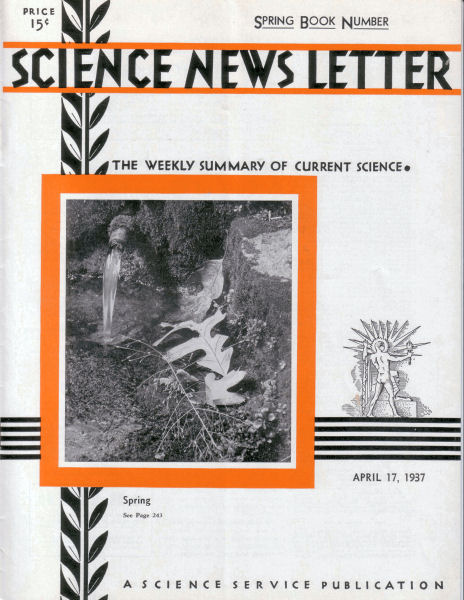From the April 17, 1937, issue

WATER AND WOODS FORM AN IDEAL PHOTOGRAPH SUBJECT
In early spring, the camera man’s fancy turns to scenes of such natural beauty as that pictured on the front cover of this week’s Science News Letter. It is from the camera of Fremont Davis, Science Service staff photographer.
MORE ELEMENTS DISCOVERED IN COLD OF INTERSTELLAR SPACE
Discovery of several new interstellar gases, two of which have been identified as neutral potassium and calcium, has been made by Dr. Theodore Dunham Jr., noted astronomer at the Carnegie Institution’s Mount Wilson Observatory.
Space between stars is filled with atoms of various elements, and Dr. Dunham’s research brings the total identified to four, one of which, calcium, appears in two forms.
Ionized calcium was the first interstellar gas to be discovered, and the discovery of neutral calcium by Dr. Dunham is considered remarkable because it is estimated that each cubic yard of space contains but one atom.
Detection of this very faint element was made possible by the development of delicate apparatus and an improvement in photographic plates.
Light from the stars Chi Orionis and 55 Cygni enabled Dr. Dunham to secure spectrograph plates of neutral calcium.
Using a new, ultrasensitive, infrared photographic plate at the Coude focus of the 100-inch telescope, the astronomer obtained evidence for the existence of neutral potassium. For this he focused the world’s largest telescope upon Chi Orionis.
Previous interstellar elements detected include ionized calcium, sodium, and titanium. Dr. Dunham and Dr. Walter S. Adams, director of Mount Wilson, announced their discovery of titanium last fall, the first new interstellar gas detected since about 1915.
Because the intensity of the lines in the spectrum produced by the newly discovered interstellar elements varies from star to star, Dr. Dunham was moved to remark that this suggests that the distribution of gas throughout interstellar space is far from uniform. In other words, these atoms appear thicker in certain parts of the sky than in others.
MAY YET TAP ATOM’S ENERGY, YALE SCIENTISTS DECLARES
Man may yet tap the atom for an almost unlimited store of energy, Dr. Ernest C. Pollard, Yale physicist, predicted. (Yale Scientific Magazine).
“Probably not, but yet—maybe” is the way he answers the query as to whether there will be practical release of energy from the atom. The key to such cheap energy would be the conversion of matter into energy, which is theoretically plausible. If atomic energy were achieved, the dreams of the ancient alchemists who hoped merely to turn lead into gold would fade into insignificance.
“The conversion of mass into energy involves multiplying by the square of the velocity of light,” Dr. Pollard explained. “This gives us such huge figures that the question arises: Can we make the energy available? It seems as though the fact that the atom’s nucleus is so small must mean a huge waste of particles in transmuting it so that the energy is bought at a high cost, and yet the past 5 years have seen transmutations brought about on a millionfold greater scale. If we could multiply yet again by 100 million, then we might be successful.”
Radioactive analysis may some day supplant ordinary chemical analysis, Dr. Pollard also predicted. Many elements have been produced in radioactive form, and if every element can be made radioactive, the progress of chemical reactions will be traceable with a degree of refinement hitherto unattainable.
Because radiations, like X rays, affect living things, changing the heredity of plants and animals, Dr. Pollard foresees that high-energy radiations may enable man to anticipate evolution.







